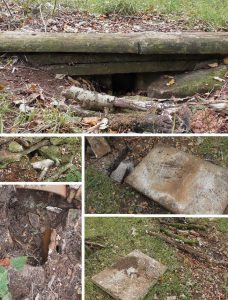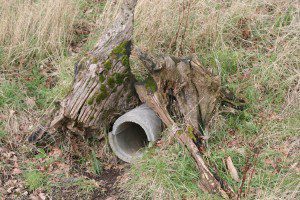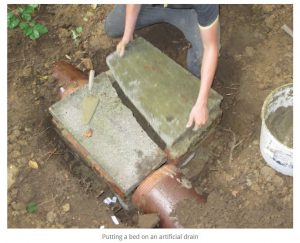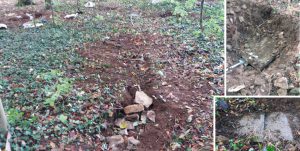The following article was written by a member of Three Counties Sabs in Autumn 2018
“Barry [Blencathra Foxhounds] drew again down Lansdale Fell, found, and hunted over to Mill Beck, marking to ground in “Porter’s Parlour”. Now I would have attempted the short climb to where they were digging, but a very interesting Mr. John Gregg came and spoke to me and told me the history of “Porter’s Parlour”. It is the largest man-made borran ever known, built about 30 years ago by Ronnie Porter. A maze of pipes and entrances exists… The fox in Porter’s Parlour was accounted for, making a total of four foxes that day… and the fifth fox of the day was added to the tally” (The Gaffer, “Spring Hunting in the Cumbrian Fells”, Hounds magazine, November ’93).
“The first artificial fox earths were constructed in order to guarantee that a fox could be found on a hunt day… also found favor because they proved easy locations for a terrier to bolt a fox from” (terriermandotcom.blogspot.co.uk).
“The earths are usually sunken concrete chambers built into the ground and connected by a network of tunnels. Foxes are encouraged to live in them and are sometimes fed and given water. They are usually built in areas near to key hunt ‘meets’, for example in woodland that will be hunted on Boxing Day or other prime occasions. The earths ensure that foxes are always available for a hunt in a specific area” wrote Paul Harris in The Observer in 2002. Many hunters prefer stone-built earths over using pipes and some incorporate ‘dropping pots’ where a terrier can easily be entered.
Even prior to the Hunting Act coming into force in February 2005 there were differing reasons given for the existence of artificial earths. Since the Hunting Act came into play it has become an even more confused situation. Not for us… it’s quite clear to us what the artificial earths around here are used for and what their purpose is, but it would appear that there is no clear consensus within the hunting community as to what to say when asked about them…
Used by gamekeepers and farmers?
“Foxes are lazy diggers” and tend to enlarge rabbit holes or use badger setts or man-made structures such as drains, hay-bale stacks and piles of rocks (‘Methods of fox control’, National Working Terrier Federation). Artificial earths can be put in areas in order to encourage foxes to live in them, the excuse being that they are then easier to find if they are causing trouble in an area, though the NWTF state that experience has shown that those which do the most damage tend to be the easiest to locate anyway (via trails of feathers, for example).
“Small farmers who have rabbit warrens to keep down the butcher’s bill are not always pleased to have a litter of cubs quartered on them in the spring… the huntsman must see that a vixen shifts her nursery to a more friendly neighbourhood” (‘Notes on Hunting the Fox, Hare, Stag and Otter’ – J. Otho Paget). Even in this scenario, the hunt is involved…
In 2002, in this article in The Observer, Simon Hart of the Countryside Alliance is referenced as saying that most artificial earths date back decades – “they are very much a legacy of the past” – and are no longer in use, that many were built in order to encourage foxes to settle somewhere away from poultry farms (implying that farmers build them for such purposes…) or away from shooting estates, and not for hunting – “it encourages foxes to lie up in areas where they are more welcome”. (What is most amusing, however, is that only 20 months prior to this, Simon Hart was quoted in this article in the Telegraph as saying “there is no secret about artificial earths. We took the Burn’s Enquiry to see artificial earths… The foxes are not forced to live there. The earths are built to encourage them to live where they can be hunted safely and do not cause a nuisance”. The Burn’s Enquiry themselves said that “…it is hard to reconcile any use of artificial earths by the hunts with the argument that foxes are a pest and that their numbers need to be controlled through hunting”).
As building artificial earths is not actually illegal, it seems unclear as to why farmers would have done this in the past but have suddenly stopped using them… Unless farmers suddenly decided that foxes were no longer a problem to them regardless of where they settled…? Why would these earths be used for so long to encourage foxes to live elsewhere and then suddenly farmers abandon them and abandon the idea?
Used by hunts to encourage breeding?
In the same article mentioned above, a spokesperson from the National Farmers’ Union states that he “would be amazed if farmers were involved. If hunts are using artificial earths for foxes, that would anger farmers”, the implication being that their use encourages the fox population in the area.
Even hunters and terriermen do not all claim that artificial earths are a thing of the past or were mainly used by farmers to keep foxes away. Nick Stevens, who worked as a terrierman for the Duke of Beaufort’s Hunt in the 1990’s wrote in ‘An Obsession’ (2010) “Over the years I have made a great many artificial [earths]… I would put six or seven in a year and it was funny how often they were used” The Duke of Beaufort himself in ‘Fox Hunting’ (1980) states that “In countries where earths are scarce it is sometimes found necessary to make artificial earths, to provide somewhere for local foxes to have their cubs… [my grandfather] felt that artificial earths should be primarily intended as breeding establishments”
J. Darcy in his article ‘Time’ (published in the magazine ‘Earth Dog, Running Dog’ in 2012) states:
‘this summer we’ve put in another artificial on a local spot that’s a bit of a magnet for foxes… it will make a real sight when a fox bolts out through it… we got it done so it’s an investment for the future, another place to check for a fox when we’re having a blank day. We’ve put a drain in each year for a good while now’.
The same author, this time in an article named ‘Drains’, published in the ‘Earth Dog, Running Dog (issue 238) in 2012, writes ‘”when the hunting season finally peters out and there seems nothing to do, I try to put in a decent artificial if I can”.
Used by hunts to provide sport?
“If providing artificial earths, you know where the damn things [foxes] are” states ‘severnmiles’ quite concisely on 11/10/06 on the Horse & Hound forum online. J. Darcy on 29th January 2009 in the www.huntinglife.com forums adds that there is “no uncertainty of how deep or where it will run… [unlike badger setts which can be complex structures]
Obviously aside from encouraging breeding in order to have foxes for chasing in an area, there’s the ‘added bonus’ of knowing where to specifically go to find a fox if it is an otherwise ‘blank day’ (hounds having picked up no scent in the area of other foxes). “A hunt without a fox to chase doesn’t look good” (huffington Post, ‘Foxes in the Barn’, 12th June 2015).
Additionally, it is far easier to bolt or dig a fox out from an artificial earth rather than a natural earth or a badger sett especially (as these are far more complex structures below ground… hence why they are so often blocked when a hunt is due to meet nearby). As “no self-respecting fox would stay above ground if he could keep below” foxes will want to find a place to shelter when being chased by a pack of hounds.
The Duke of Beaufort in ‘Fox Hunting’ wrote “favourite coverts are so bare after Christmas that they seldom hold a fox. Such country may be opened up by the construction of an artificial earth… if an artificial earth is left open, it will only take a few minutes to bolt a fox… if it is a blank day, one knows where to go with some certainty of finding a fox”.
In ‘Hunt and Working Terriers’, this is backed up by Jocelyn Lucas who writes “where coverts are small and scattered it is a great advantage to have snug earths at regular intervals, and judiciously placed earths in a covert are often a means of persuading a fox to take a good line”. In short, a fox will run to areas where they know there is somewhere they can hide up and, if an earth is blocked, will run to the next area they know. Lucas goes on, “big breeding earths must need be kept stopped, but if an artificial earth is left open, small matter, it is only a matter of a few minutes at most to bolt a fox, and if none be found above ground, one knows where one may be found”.
In June 1998 the Animal Cruelty Investigation Group found 2 cubs caged into an artificial earth in a wood owned by the Sinnington Foxhounds – a local informant had told investigators that a gamekeeper killed a vixen then ‘rescued’ the orphaned cubs, giving them to the hunt: YouTube Video
That year Clifford Pellow was quoted in an article in the Independent entitled ‘More hunts in fox-breeding scandal’ (26/6/98) stated that the practice was commonplace and said that “artificial earths ensure foxes are attracted to the area and provide foxes for poor scent days… the theory of pest control is a joke “. As a kennelman and huntsman for 23 years before turning anti, he knew a thing or two about hunting practices…
In May 2015 similar scenes were released by the League Against Cruel Sports from the Pytchley Hunt, including footage of hounds hunting through the covert in which the arttificial earth was situated…
In “Methods of fox control (pre-ban)” the Masters of Fox Hounds Association state, in order to argue that foxhunting is a ‘fair sport’ that “the fox is always hunted in territory with which it is familiar. It will know where to go to give itself the best chance of escape”.
How are they made?
A number of different materials may be used to create an artificial earth and there are a few different designs that are commonly found dotted around the countryside. The main points made in various articles and in forums are to ensure that designs avoid draughts, are well-drained and have a bit of a slope. Dry stone wall, plastic piping, railways sleepers, stone, bricks, tyres, ceramic… there is no hard and fast rule on material used, though everyone has their preferences.
“A simple artificial earth for training purposes can be made of wood covered over with earth. It should be made with a bend or two in it, so that a dog cannot see through it” (‘Hunt and Working Terriers’, Jocelyn Lucas).
The Animal Cruelty Investigation Group and Animal Welfare Information Service (ACIGAWIS) have some fantastic information on their site regarding artificial earths, hunting and other issues. The following two paragraphs are copied from their page on AEs:
AEs are below ground structures that usually consist of at least two tunnels and a central chamber. The tunnels can be constructed of 9″ diameter glazed pipes, concrete pipes, or building blocks. In some parts of the country, particularly Cumbria, the tunnels are commonly made of corrugated iron bent into an inverted V shape. The chamber can be built of bricks, building blocks, logs or similar.
The roof of the chamber is usually two or more paving slabs, or steel plate or corrugated iron. This roof is then covered with soil, branches or turf for concealment. There will usually be something to hand to facilitate quick blocking of the tunnel entrances. This might be a building block, a large log or a steel grid.
“I think it’s all about the siteing [sic] of the artificial, more than the layout of it” states ‘dogs-n-natives’ on 17/6/2008 on www.huntinglife.com/forums
An issue brought up in many hunting books and articles is mange. “Artifical earths, I have been told, if not made in a dry situation, are often the cause of foxes being mangy” (Donald Cook – ‘Observation on Foxhunting and The Management of Hounds”).
“It should be bourne into mind that an artificial earth is frequently the means of introducing mange into a country” (Duke of Beaufort, ‘Fox Hunting’). Jocelyn Lucas mentions that artificial earths are “purposefully made shallow as a rule in order to expedite bolting operations if these should be needed” but also states that “deep and dry is the Colonel’s motto” in order to try and avoid mange, as AEs are “a great source” of it.
J. Otho Paget in ‘Hunting – Notes on Hunting the Fox, Hare, Stag and Otter’ goes further to say that because “they are also a means of spreading the mange… they should all be closed until the district can show a clean bill of health”.
Our experiences
Many of the artificial earths found in the three counties and, indeed, across the country, are not in a state of disrepair. Some show signs of regular maintenance, others are obviously new-builds, some have had recent repairs after recent dig-outs, most smell of fox or badger (not all are ‘badger-proof’) and many have fresh animal carcasses or other food left nearby, obviously placed there as opposed to being taken or dragged there by the foxes themselves.
We know fine well that many of our hunts use artificial earths. In November 2016 during the opening meet of the hunting season for the Duke of Beaufort’s Hunt members of Three Counties Sabs and Cirencester Illegal Hunt Watch caught Beaufort terriermen and pals digging at an artificial earth situated on land owned by the hunt itself in Badminton just minutes after hounds had set off from the kennels. Another artificial earth had been freshly blocked up, found alongside a badger sett, also blocked, to prevent foxes being able to go to ground during the hunt.
In January 2018, a member of 3C caught terrierman Will Haines, employed by the North Cotswold Hunt, putting a terrier into an artificial earth at a meet of the hunt…
… we have previously caught the hunt messing around with artificial earths. Three were found in a small woodland at the end of a hunt meet in December 2016 when hunt members, ‘falconer’ Calvin Crossman and terriermen attempted to prevent our sabs from discovering the artificial earths (on film at the end of the next video)
This is by no means an exhaustive list of our experiences with hunts and artificial earths, merely a snapshot of the types of activity we’ve witnessed. Similar scenes happen each week up and down the country with different hunts.
What can be done about them?
In early 2018 we put out a report that was written just prior to the opening meets of the hunting season in our area. Under the name ‘Operation Kitsune’ an anonymous group of people damaged and / or destroyed a number of artificial earths. For the full report please click here
Before his death, ex-huntsman (and long-term anti-hunt campaigner) Clifford Pellow told sabs from our group that the best thing to do with any artificial earths found was to destroy them and put them out of action. Artificial earths have been filmed on a number of occasions and, while footage can be useful in showing what the hunts are still up to as well as adding an extra nail in the coffin of a hunt who are having a larger case built against them, they’re also the reason that many foxes are killed during hunt meets… so the advice is to get rid of them, whether filming them first or not.
We have various investigations going on in our parts of the country so if you know the location of any artificial earths please let us know – it could be that we already have something going on with it or it could be new to us so a quick chat about it is always appreciated!




